023. Great-winged Petrel Pterodroma macroptera (Langvlerkstormvoël)
Order: Procellariiformes. Family: Procellariidae
Description
Length 40-41 cm. Wingspan 97 cm.
An all dark petrel with silvery flashes in outer flight feathers in good light. The bird is completely dark brown except for a variable patch of white near the base of the bill. Long-winged and thick-necked with a large, dark bill. The short and stout legs and feet are black. Iris brown.
Juvenile: as adult but with more distinct grey face patch.
Similar species: Differs from similarly sized Sooty Shearwater by having a dark, not silvery underwing. Told from the much larger White-chinned Petrel by its short, black (not long, pale) bill.
Distribution
In a band between the Tropic of Capricorn to the Antarctic circle from central South Atlantic to Australia. Breeds on sub-Antarctic islands and islands off New Zealand and south-west Australia, after which it disperse across southern oceans from 20-48° South. It is common in across southern African waters, although more scarce off Mozambique and northern Namibia.
Habitat
Pelagic.
Movements and migrations
Breeds in winter from about February and August, while present in southern African waters from September-May, with numbers peaking from November-March.
Diet
It mainly eats squid, supplemented with crustaceans, carrion, tunicates and fish, doing most of its foraging at night, grabbing prey from the water surface.
Breeding
April onwards. Solitary or in loose colonies. Single egg incubated for 53-55 days. Chicks fledge after 108-128 days.
Status
Common visitor offshore.
Africa Wild Bird Book
Great-winged Petrel Photos
023. Great-winged Petrel Pterodroma macroptera (Langvlerkstormvoël)
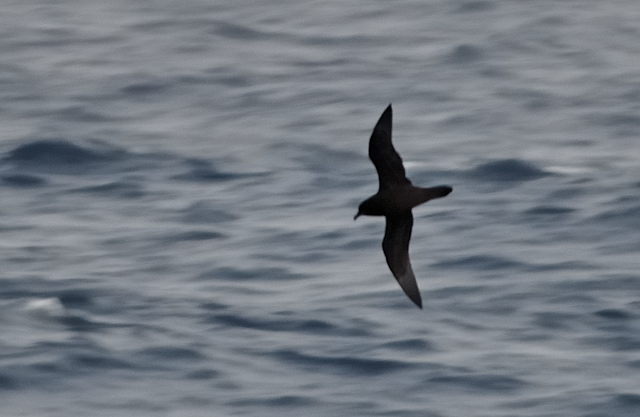
Links:
Sabap2: http://sabap2.adu.org.za/spp_summary.ph ... §ion=3
Sasol
NEWMAN'S VOELS VAN SA (8ste UIT)
Trevor Hardaker Photos

Links:
Sabap2: http://sabap2.adu.org.za/spp_summary.ph ... §ion=3
Sasol
NEWMAN'S VOELS VAN SA (8ste UIT)
Trevor Hardaker Photos
Soft-plumaged Petrel
024. Soft-plumaged Petrel Pterodroma mollis (Donsveerstormvoël)
Order: Procellariiformes. Family: Procellariidae
Description
Length 34 cm, wingspan 89 cm. Shows a dark, blackish head and cheeks, a whitish forehead with darker mottling, and a broad blackish eye-mark, a dark, grey nape and back, dark upperwings and a long pale grey tail. Upperparts grey with indistinct dark M across wings and back. Underparts white with grey band on upper breast. Underwings dark grey with feint pale line in good light. The bill is black. The legs are flesh-pink with black tipped webs.
The Soft-plumaged Petrel occurs in a very rare dark phase which could be confused with the all-dark-brown Great-winged Petrel, but the latter species is much larger and has a grizzled face.
Similar species: Resembles Atlantic Petrel but is much smaller and has a white throat.
Distribution
Southern Ocean from East coast of South America to New Zealand in a band between the Tropic of Capricorn to the Antarctic Convergence. Breeds on sub-Antarctic islands as well as on Maatsuyker Island off Tasmania, after which it disperses across southern oceans from 20-50° South, including southern African waters. Here it is common off South Africa and southern Namibia but more scarce further north and closer to the coast.
Habitat
Pelagic.
Movements and migrations
Mainly present at its breeding colonies from August-May, hence although it is seen year-round in southern African waters, it is most common in the period from May-October.
Diet
Cephalapods, crustaceans and small fish. It forages by grabbing prey from the water surface. It sometimes associates with dolphins and toothed whales, catching prey they disturb or alternatively following fishing vessels to grab discards and offal.
Breeding
September onwards. Colonialy in burrows. Single egg incubated for approx. 50 days. Chicks fledge after 90-92 days.
Status
Fairly common visitor offshore in winter and spring.
Order: Procellariiformes. Family: Procellariidae
Description
Length 34 cm, wingspan 89 cm. Shows a dark, blackish head and cheeks, a whitish forehead with darker mottling, and a broad blackish eye-mark, a dark, grey nape and back, dark upperwings and a long pale grey tail. Upperparts grey with indistinct dark M across wings and back. Underparts white with grey band on upper breast. Underwings dark grey with feint pale line in good light. The bill is black. The legs are flesh-pink with black tipped webs.
The Soft-plumaged Petrel occurs in a very rare dark phase which could be confused with the all-dark-brown Great-winged Petrel, but the latter species is much larger and has a grizzled face.
Similar species: Resembles Atlantic Petrel but is much smaller and has a white throat.
Distribution
Southern Ocean from East coast of South America to New Zealand in a band between the Tropic of Capricorn to the Antarctic Convergence. Breeds on sub-Antarctic islands as well as on Maatsuyker Island off Tasmania, after which it disperses across southern oceans from 20-50° South, including southern African waters. Here it is common off South Africa and southern Namibia but more scarce further north and closer to the coast.
Habitat
Pelagic.
Movements and migrations
Mainly present at its breeding colonies from August-May, hence although it is seen year-round in southern African waters, it is most common in the period from May-October.
Diet
Cephalapods, crustaceans and small fish. It forages by grabbing prey from the water surface. It sometimes associates with dolphins and toothed whales, catching prey they disturb or alternatively following fishing vessels to grab discards and offal.
Breeding
September onwards. Colonialy in burrows. Single egg incubated for approx. 50 days. Chicks fledge after 90-92 days.
Status
Fairly common visitor offshore in winter and spring.
Soft-plumaged Petrel Photos
024. Soft-plumaged Petrel Pterodroma mollis (Donsveerstormvoël)
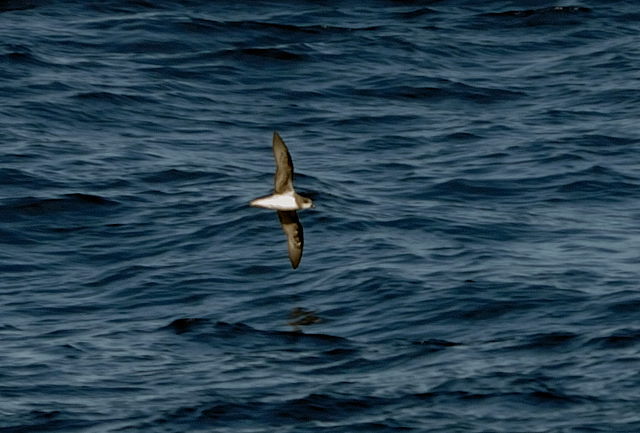
Links:
Sabap2
Trevor Hardaker Photos

Links:
Sabap2
Trevor Hardaker Photos
White-chinned Petrel
032. White-chinned Petrel Procellaria aequinoctialis (Bassiaan)
Order: Procellariiformes. Family: Procellariidae
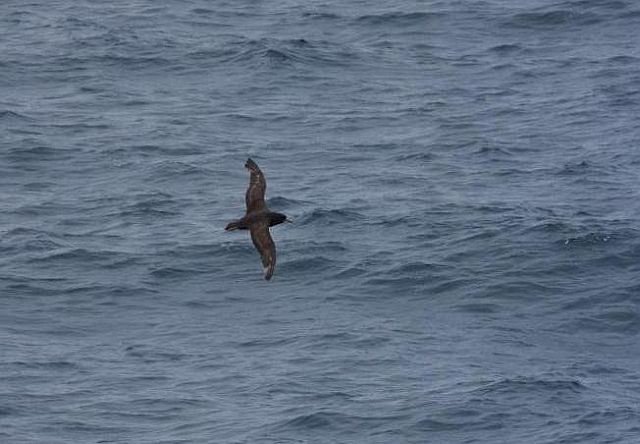
Description
55 cm in length. 147 cm in wingspan. This large petrel is sooty-black and has some white on its throat and chin (it may encompass the whole throat and cheeks or may be absent, more white in the Indian Ocean sector than the Atlantic). Its primaries can have a silvery appearance underneath. Its bill may be horn or greenish-yellow with black central culmen. The eyes are dark brown. Legs and webbed feet are black.
Differs from ohter dark brown petrels by its large size and the long robust, pale greenish white bill with black saddle.
Distribution
Breeds on sub-Antarctic islands, from the Falklands to islands south-west of New Zealand, dispersing across southern oceans between 30-65° South (extending further north along the west coasts of South America and Africa). It is common across southern African waters, while scarce to absent in the north-west and north-east. Most birds are of the nominate subspecies breeding at circumpolar subantarctic islands during the austral summer. Nonbreeding birds disperse throughout the Southern Ocean. The spectacled form, P. a. conspicillata, restricted as a breeding species to Inaccessible Island in the Tristan group, is a scarce visitor to the west coast of southern Africa, primarily in winter.
Habitat
Southern oceans.
Movements and migrations
Present year-round of the south and west coast of southern Africa, although especially common in winter, as most birds return to their colonies in September.
Diet
Their diet is composed mainly of krill followed by fish. White-chinned Petrels feed by surface seizing and by undertaking shallow dives, and they will readily follow ships to collect fisheries discards.
Breeding
The breeding season usually starts in October to mid-November, and the birds return to the breeding colonies in late September. The White-chinned Petrel nests in burrow, excavated in soft soil below tussocks of grasses. Such burrow may be up to two metres long. The nest-chamber includes a dry platform of earth and vegetation. The female lays only one egg after a period of abundant feeding. Both parents incubate during 57-62 days, with stints of several days, between 1 and 19. But they often leave the egg for foraging during some days. The downy chick is dark brown. It is brooded only for few hours. The young fledge about 87-106 days after hatching. When the chick is fully-feathered, the adults stop their visits. It has to learn how to feed itself, and leaves the burrow some days later to reach the sea.
Status
Common all-year visitor. Classified as Vulnerable (VU) on the IUCN Red List.
Order: Procellariiformes. Family: Procellariidae

Description
55 cm in length. 147 cm in wingspan. This large petrel is sooty-black and has some white on its throat and chin (it may encompass the whole throat and cheeks or may be absent, more white in the Indian Ocean sector than the Atlantic). Its primaries can have a silvery appearance underneath. Its bill may be horn or greenish-yellow with black central culmen. The eyes are dark brown. Legs and webbed feet are black.
Differs from ohter dark brown petrels by its large size and the long robust, pale greenish white bill with black saddle.
Distribution
Breeds on sub-Antarctic islands, from the Falklands to islands south-west of New Zealand, dispersing across southern oceans between 30-65° South (extending further north along the west coasts of South America and Africa). It is common across southern African waters, while scarce to absent in the north-west and north-east. Most birds are of the nominate subspecies breeding at circumpolar subantarctic islands during the austral summer. Nonbreeding birds disperse throughout the Southern Ocean. The spectacled form, P. a. conspicillata, restricted as a breeding species to Inaccessible Island in the Tristan group, is a scarce visitor to the west coast of southern Africa, primarily in winter.
Habitat
Southern oceans.
Movements and migrations
Present year-round of the south and west coast of southern Africa, although especially common in winter, as most birds return to their colonies in September.
Diet
Their diet is composed mainly of krill followed by fish. White-chinned Petrels feed by surface seizing and by undertaking shallow dives, and they will readily follow ships to collect fisheries discards.
Breeding
The breeding season usually starts in October to mid-November, and the birds return to the breeding colonies in late September. The White-chinned Petrel nests in burrow, excavated in soft soil below tussocks of grasses. Such burrow may be up to two metres long. The nest-chamber includes a dry platform of earth and vegetation. The female lays only one egg after a period of abundant feeding. Both parents incubate during 57-62 days, with stints of several days, between 1 and 19. But they often leave the egg for foraging during some days. The downy chick is dark brown. It is brooded only for few hours. The young fledge about 87-106 days after hatching. When the chick is fully-feathered, the adults stop their visits. It has to learn how to feed itself, and leaves the burrow some days later to reach the sea.
Status
Common all-year visitor. Classified as Vulnerable (VU) on the IUCN Red List.
White-chinned Petrel Photos
032. White-chinned Petrel Procellaria aequinoctialis (Bassiaan)
 © Dewi
© Dewi
 © Dewi
© Dewi
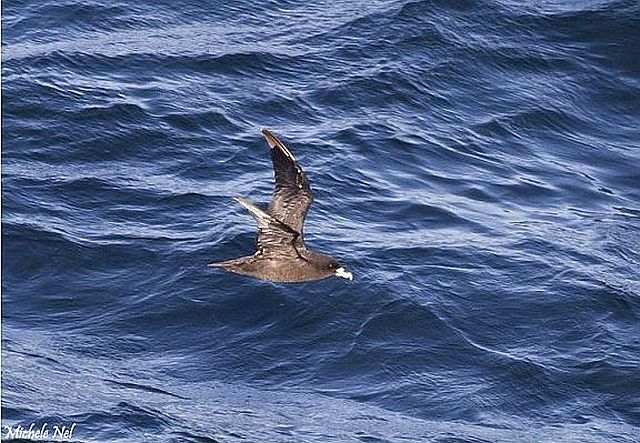 © Michele Nel
© Michele Nel
 © Michele Nel
© Michele Nel
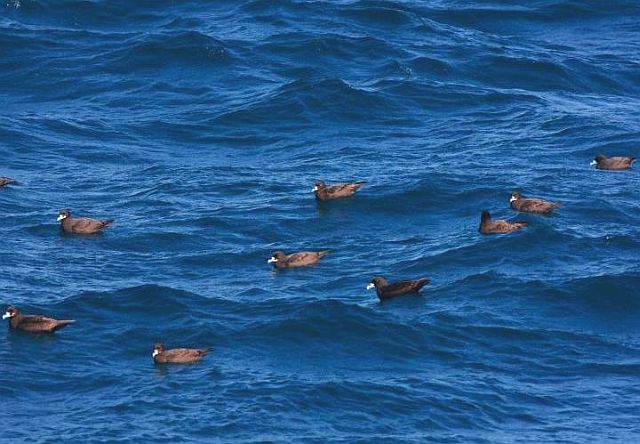
Links:
Species text Sabap1: http://sabap2.adu.org.za/docs/sabap1/032.pdf
Sabap2: http://sabap2.adu.org.za/spp_summary.ph ... §ion=3
Sasol
NEWMAN'S VOELS VAN SA (8ste UIT)
ARKive: http://www.arkive.org/white-chinned-pet ... noctialis/
Oiseaux net: http://www.oiseaux-birds.com/card-white ... etrel.html
ACAP Species assesment
 © Dewi
© Dewi © Dewi
© Dewi © Michele Nel
© Michele Nel © Michele Nel
© Michele Nel
Links:
Species text Sabap1: http://sabap2.adu.org.za/docs/sabap1/032.pdf
Sabap2: http://sabap2.adu.org.za/spp_summary.ph ... §ion=3
Sasol
NEWMAN'S VOELS VAN SA (8ste UIT)
ARKive: http://www.arkive.org/white-chinned-pet ... noctialis/
Oiseaux net: http://www.oiseaux-birds.com/card-white ... etrel.html
ACAP Species assesment
Grey Petrel
033. Grey Petrel Procellaria cinerea (Pediunker)
Order: Procellariiformes. Family: Procellariidae

Description
The Grey Petrel is a large grey, white, and brown Petrel. Upperparts a light, sooty grey with darker areas on the head and tail. The crown, wings, back and tail are a dark ash gray colour, while the cheeks and the sides and nape of the neck are pale grey. Underparts white with a grey tail and grey underwings. They have a yellow-green bill and pink-grey feet.
Similar species: This petrel superficially resembles Cory's Shearwater, from which it can be told by its dark underwing and undertail. The grey-brown of the head extends very low on the cheeks, leaving only a narrow white throat patch, with the result that at long range this species can appear dark headed.
Distribution
Circumpolar between the Tropic of Capricorn South to the Antarctic Convergenge. Breeds in winter at sub-Antarctic islands from Tristan da Cunha the Antipodes, after which it disperses across southern Oceans, generally staying below the Subtropical Front. It is rare in southern African waters with about 1-2 records per year, most of which are concentrated in the far south of the region, although it is occasionally recorded closer to the coast of South Africa.
Habitat
Pelagic.
Diet
Squid, fish, crustaceans and offal. It forages by grabbing prey from the water surface or plunge diving from 3-8 metres above the water.
Breeding
February-March. The Grey Petrel breeds in colonies, making its nest in burrows. The breeding ecology of this little understood, winter breeding bird was studied on the Kerguelen Archipelago, where adults were recorded to mate in February. A single egg would be laid in early April, and hatching took place in late May to early June. The fledging period of 120 to 160 days is the longest known among the petrels, with a long fledging period being particularly associated with southern winter breeding species.sts colonially in burrows.
Status
Rare Summer vagrant to the waters off the Cape. Classified as Near Threatened (NT) on the IUCN Red List.
Order: Procellariiformes. Family: Procellariidae

Description
The Grey Petrel is a large grey, white, and brown Petrel. Upperparts a light, sooty grey with darker areas on the head and tail. The crown, wings, back and tail are a dark ash gray colour, while the cheeks and the sides and nape of the neck are pale grey. Underparts white with a grey tail and grey underwings. They have a yellow-green bill and pink-grey feet.
Similar species: This petrel superficially resembles Cory's Shearwater, from which it can be told by its dark underwing and undertail. The grey-brown of the head extends very low on the cheeks, leaving only a narrow white throat patch, with the result that at long range this species can appear dark headed.
Distribution
Circumpolar between the Tropic of Capricorn South to the Antarctic Convergenge. Breeds in winter at sub-Antarctic islands from Tristan da Cunha the Antipodes, after which it disperses across southern Oceans, generally staying below the Subtropical Front. It is rare in southern African waters with about 1-2 records per year, most of which are concentrated in the far south of the region, although it is occasionally recorded closer to the coast of South Africa.
Habitat
Pelagic.
Diet
Squid, fish, crustaceans and offal. It forages by grabbing prey from the water surface or plunge diving from 3-8 metres above the water.
Breeding
February-March. The Grey Petrel breeds in colonies, making its nest in burrows. The breeding ecology of this little understood, winter breeding bird was studied on the Kerguelen Archipelago, where adults were recorded to mate in February. A single egg would be laid in early April, and hatching took place in late May to early June. The fledging period of 120 to 160 days is the longest known among the petrels, with a long fledging period being particularly associated with southern winter breeding species.sts colonially in burrows.
Status
Rare Summer vagrant to the waters off the Cape. Classified as Near Threatened (NT) on the IUCN Red List.
-
Michele Nel
- Posts: 1994
- Joined: Mon Sep 10, 2012 10:19 am
- Country: South Africa
- Location: Cape Town
- Contact:
Cory's Shearwater
034. Cory's Shearwater Calonectris diomedea (Geelbekpylstormvoel)
Order: Procellariiformes. Family: Procellariidae
Description
Length 45-48 cm. Wingspan 100-125 cm. Weight 560-1060 g. Large shearwater, brown and white, with a strong, distinctive flight, gliding above the ocean with only occasional deep beats of its long, often bowed wings, with yellowish bill and lack of clear demarcation between grey- brown head and white chin and throat. The upperparts are grey-brown, with paler edges to the feathers of the back, mantle and upper tail. The underparts are white. The underside of the tail is dark, and the undersides of the wings are white, with dark front and rear edges and a dark tip. There may sometimes be a pale crescent at the base of the tail. The head is also greyish-brown, and the long, stout, strongly hooked beak is yellow with a dark tip.
The male is larger than the female, and juveniles resemble the adult.
Similar species: The ashy brown upperparts and lack of both the dark-capped effect and pale collar distinguish this large, heavy-bodied species from the Great Shearwater. Great Shearwater is about the same size with darker wings and body, smaller bill is black, narrow straight wings, capped appearance, smudgy brown on belly (sometimes faint), and white collar.
Manx Shearwater is much smaller with no white collar, no white tail band, totally white belly and undertail coverts, and much more blackish.
Distribution
Breeds on islands in the Mediterranean and north-west Atlantic Ocean, after which it heads through the Atlantic Ocean, to the western Indian Ocean. A common summer visitor to southern Africa, while especially off the western and southern coast, while more scarce off the south-eastern coast.
Habitat
A bird of the open ocean, Cory’s Shearwater is rarely seen near land, returning to barren offshore islands only to breed.
Movements and migrations
Present at its breeding colonies from late February to October and November, while most common in southern African waters in the period from November-May.
Diet
It mainly eats fish, supplemented with shrimps, squid and cuttlefish, doing most of its foraging by catching prey from the water surface or plunge-diving up to a depth of about five metres. It also regularly feeds in association with dolphins, toothed whales, gamefish and dolphins, catching prey that they disturb.
Breeding
Cory’s Shearwater breeds in colonies mainly on islands and cliffs in the Mediterranean. The nest is build at the end of a burrow or rock crevice, which may measure up to one metre in length. It is believed to be monogamous, and breeding pairs will often occupy the same nest site over successive years. The breeding season usually runs from March to November, and egg-laying is highly synchronised, with most birds in a colony laying at around the same time. The female lays a single, white egg, either on bare ground or on top of small stones and shells. The male and female take turns at incubation, in ‘shifts’ of 6 to 8 days, and the egg hatches after 52 to 62 days. The chick is covered in grey-brown down, and both the chick and the adults are able to defend the nest by regurgitating a noxious stomach oil onto intruders. The parents care for the young for up to 100 days.
Call
A long wail and a gull-like ia-gowa-gow. Listen to Bird Call.
Status
Common summer visitor.
Order: Procellariiformes. Family: Procellariidae
Description
Length 45-48 cm. Wingspan 100-125 cm. Weight 560-1060 g. Large shearwater, brown and white, with a strong, distinctive flight, gliding above the ocean with only occasional deep beats of its long, often bowed wings, with yellowish bill and lack of clear demarcation between grey- brown head and white chin and throat. The upperparts are grey-brown, with paler edges to the feathers of the back, mantle and upper tail. The underparts are white. The underside of the tail is dark, and the undersides of the wings are white, with dark front and rear edges and a dark tip. There may sometimes be a pale crescent at the base of the tail. The head is also greyish-brown, and the long, stout, strongly hooked beak is yellow with a dark tip.
The male is larger than the female, and juveniles resemble the adult.
Similar species: The ashy brown upperparts and lack of both the dark-capped effect and pale collar distinguish this large, heavy-bodied species from the Great Shearwater. Great Shearwater is about the same size with darker wings and body, smaller bill is black, narrow straight wings, capped appearance, smudgy brown on belly (sometimes faint), and white collar.
Manx Shearwater is much smaller with no white collar, no white tail band, totally white belly and undertail coverts, and much more blackish.
Distribution
Breeds on islands in the Mediterranean and north-west Atlantic Ocean, after which it heads through the Atlantic Ocean, to the western Indian Ocean. A common summer visitor to southern Africa, while especially off the western and southern coast, while more scarce off the south-eastern coast.
Habitat
A bird of the open ocean, Cory’s Shearwater is rarely seen near land, returning to barren offshore islands only to breed.
Movements and migrations
Present at its breeding colonies from late February to October and November, while most common in southern African waters in the period from November-May.
Diet
It mainly eats fish, supplemented with shrimps, squid and cuttlefish, doing most of its foraging by catching prey from the water surface or plunge-diving up to a depth of about five metres. It also regularly feeds in association with dolphins, toothed whales, gamefish and dolphins, catching prey that they disturb.
Breeding
Cory’s Shearwater breeds in colonies mainly on islands and cliffs in the Mediterranean. The nest is build at the end of a burrow or rock crevice, which may measure up to one metre in length. It is believed to be monogamous, and breeding pairs will often occupy the same nest site over successive years. The breeding season usually runs from March to November, and egg-laying is highly synchronised, with most birds in a colony laying at around the same time. The female lays a single, white egg, either on bare ground or on top of small stones and shells. The male and female take turns at incubation, in ‘shifts’ of 6 to 8 days, and the egg hatches after 52 to 62 days. The chick is covered in grey-brown down, and both the chick and the adults are able to defend the nest by regurgitating a noxious stomach oil onto intruders. The parents care for the young for up to 100 days.
Call
A long wail and a gull-like ia-gowa-gow. Listen to Bird Call.
Status
Common summer visitor.
-
Michele Nel
- Posts: 1994
- Joined: Mon Sep 10, 2012 10:19 am
- Country: South Africa
- Location: Cape Town
- Contact:
Cory's Shearwater Photos
034. Cory's Shearwater Calonectris diomedea (Geelbekpylstormvoel)
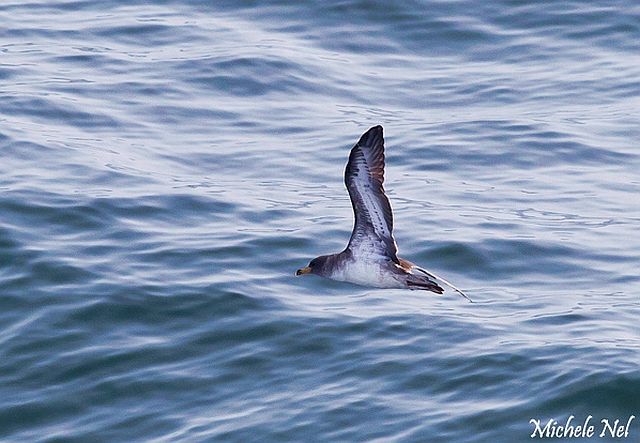
Links:
Species text Sabap1: http://sabap2.adu.org.za/docs/sabap1/034.pdf
Sabap2: http://sabap2.adu.org.za/spp_summary.ph ... §ion=3
Biodiversity Explorer
Sasol
ARKive: http://www.arkive.org/corys-shearwater/ ... -diomedea/
Trevor Hardaker Photos

Links:
Species text Sabap1: http://sabap2.adu.org.za/docs/sabap1/034.pdf
Sabap2: http://sabap2.adu.org.za/spp_summary.ph ... §ion=3
Biodiversity Explorer
Sasol
ARKive: http://www.arkive.org/corys-shearwater/ ... -diomedea/
Trevor Hardaker Photos



